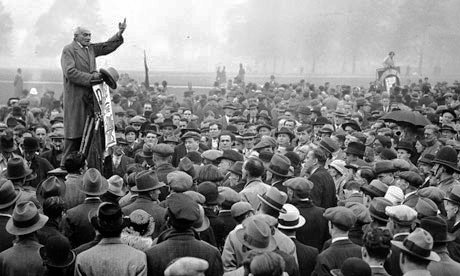
(Source: Keystone/Getty Images)
The Hanseatic League - who were they really?
The ‘History Revolution’ of the early 20th century
Regular readers will know that one of our favourite ‘soap-boxes’ is that of the mutilation and redefinition of Britain’s history. Being British ourselves this may be considered as purely ‘national pride’ and whilst that kind of thing is not allowed these days, there is undoubtedly an element of it involved. However, the scale and persistence of it is so extraordinary it’s as if we are being forced to believe that white is black. The phenomenal amount of effort that’s been dedicated to achieving this and the duplicity of its intent, stand out like a beacon proclaiming it’s British history that’s been invaded and conquered, not Britain. As this beacon proves – there’s no smoke without fire and its light, being the true legacy of Britain, must have shone so brightly that those who had to extinguish it at all costs couldn’t bear to behold it.

(Source: Keystone/Getty Images)
In this article, which should be considered as belonging to the Dark Earth Chronicles series, it will be seen that this ‘soap box’ of ours is nothing new and that better people than us have already made attempts to shine a light on our extinguished past and at a very specific time – a time which could be highly significant to us today.
Just over one hundred years ago, Harold Bayley wrote a book entitled ‘Archaic England’. It was published in 1919, just after the First World War. In his article The Nature of the Beast Part 4, Felix defined World War One as “the defining point between two ages. Western civilisation lost its impetus and in spite of space rockets, the Beatles, the Pill, the Internet and all the technological gadgets, the fundamentals of civilisation remained static, or it could even be said that they deteriorated.” He also quoted Rudolph Steiner who claimed that the actual causes of the war had been made so nefarious and complicated that Europeans were unable or just too lazy to seek the truth. As a direct result of this they became paralysed with fear. This fear created the poisonous climate into which the spark of war could be thrown. If you consider that as a modus operandi, then it’s very much still in use to this very day.
Furthermore, this quote is worth repeating here…
“...the events of the war could not be understood without taking into account the existence and activities of elite brotherhoods in the West—mostly of a Masonic or semi-Masonic nature—with a deep occult knowledge of the human being and of the evolution of consciousness. They abused this knowledge and put it at the service of special interest groups, one-sided national egoisms, in order to bring about far-reaching historical aims. These brotherhoods were masters at the grey (the media) and black (ritual) arts of manipulation, at long-range planning, networking of all kinds and, above all, ensuring the right people were in the right place at the right time.” Source
The fear was obviously deliberately created as a distraction from the changes that were planned for the coming century. Is this significant? Could it be that there is some kind of energy available during the change of century which can assist the introduction of change within society? Are centuries “revolutionary” both in the chronological and political sense? If so, was fear used to distract the masses from instigating beneficial changes of their own design?
Anyway, it was within this general atmosphere that dear old Harold Bayley was writing his book. It’s contents show quite clearly how, despite the fear, certain breakthroughs had been made immediately prior to this period...
“The fact is now generally accepted as proven by both anthropologists and archæologists, that the most ancient records of the human race exist not in Asia, but in Europe. The oldest documents are not the hieroglyphics of Egypt, but the hunting-scenes scratched on bone and ivory by the European cave-dwelling contemporaries of the mammoth and the woolly rhinoceros. Human implements found on the chalk plateaus of Kent have been assigned to a period prior to the glacial epoch, which is surmised to have endured for 160,000 years, from, roughly speaking, 240,000 to 80,000 years ago...
“...It is now also an axiom that the races of Europe are not colonists from somewhere in Asia, but that, speaking generally, they have inhabited their present districts more or less continuously from the time when they crept back gradually in the wake of the retreating ice...
“...Written history and popular tradition,' says Sir E. Ray Lankester, 'tell us something in regard to the derivation and history of existing ‘peoples,’ but we soon come to a period—a few thousand years back—concerning which both written statement and tradition are dumb. And yet we know that this part of the world—Europe—was inhabited by an abundant population in those remote times.'”
It’s important to stress that an “axiom is a statement or principle that is generally accepted to be true, or a formal statement in mathematics, science, etc., from which other statements can be obtained.” (Source) The use of this word shows that there was some kind of a revolution going on within the intelligentsia of historical research at that time. I haven’t been able to find any personal information regarding Harold Bayley other than that he is now regarded as ‘quaint’, “Harold Bayley, a figure not extensively recognized in the contemporary realms of literary scholarship, made enduring contributions to the study of English history and etymology through his engaging body of work.” Source
Wikiperdido will tell you he was a cricketer from the same period (which he wasn’t.) He had seven books published between 1902 and 1939, but there were still 12 books “waiting to be published” in 1939, sadly none of them are traceable today. It’s not possible to know if he served in the war between 1914 and 1918 and therefore wasn’t able to write, but it does seem likely. This would mean that the period he was writing about above was before the war.
Felix also wrote, “Issues such as the use of energy, the direction of medicine, the grip of materialism on intellectual life, relations between the sexes and classes, the problem of nationalism, the nature of architecture and music, were all on the cusp of creative new solutions at the very beginning of the 20th century. Those innovations were either lost or corrupted by the ‘Great War’ and the same issues remain unresolved today.”
So, it would appear that we can also add 'The Revision of History' to that list and this may also provide yet another pressing motive for the instigation of the war itself.
Harold Bayley reveals more of this radical new thinking as it was then...
“It has been claimed for the Welsh that they possess the oldest literature in the oldest language in Europe. Giraldus Cambrensis, speaking of the Welsh Bards, mentions their possession of certain ancient and authentic books, but whether or not the traditionary poems which were first committed to writing in the twelfth century [WS: The Mabinogi] retain any traces of the prehistoric Faith is a matter of divided opinion. To those who are not experts in archaisms and are not enamoured of ink-spilling, the sanest position would appear to be that of Matthew Arnold, who observes in Celtic Literature: “There is evidently mixed here, with the newer legend, a detritus, as the geologists would say, of something far older; and the secret of Wales and its genius is not truly reached until this detritus, instead of being called recent because it is found in contact with what is recent, is disengaged, and is made to tell its own story.”
It’s precisely by sifting through this “detritus” and allowing it to tell its own story that we stand a chance of discovering the true nature of what came before the 10th century cataclysm, the cause of the cataclysmic event itself, what came after and its true effect upon the civilisation we have inherited. It’s very interesting to note that of the 12 books that Harold Bayley never published, one was called ‘King Arthur’ and the title of the subsequent one was called ‘Noah's Ark (A sequel to King Arthur)’. This would indicate that Harold Bayley associated the end of King Arthur’s reign with a cataclysm. But before we get too deeply involved in that, it’s interesting to hear some more of Harold Bayley’s ‘blasphemies’...
“Druids or no Druids there must at some period in our past have been interesting and enterprising people in these islands. At Avebury, near Marlborough, is Silbury Hill, an earth mound, which is admittedly the vastest artificial hill in Europe. Avebury itself is said to constitute the greatest megalithic monument in Europe, and nowhere in the world are tumuli more plentiful than in Great Britain…”
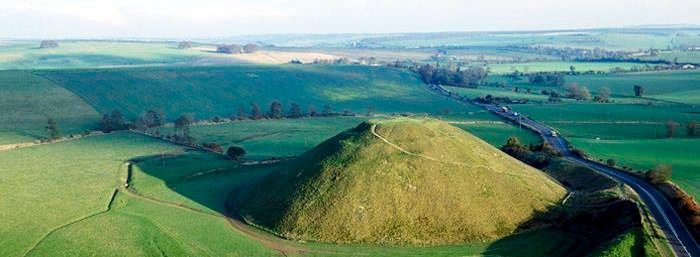
Silbury Hill, Avebury, Wiltshire
Source
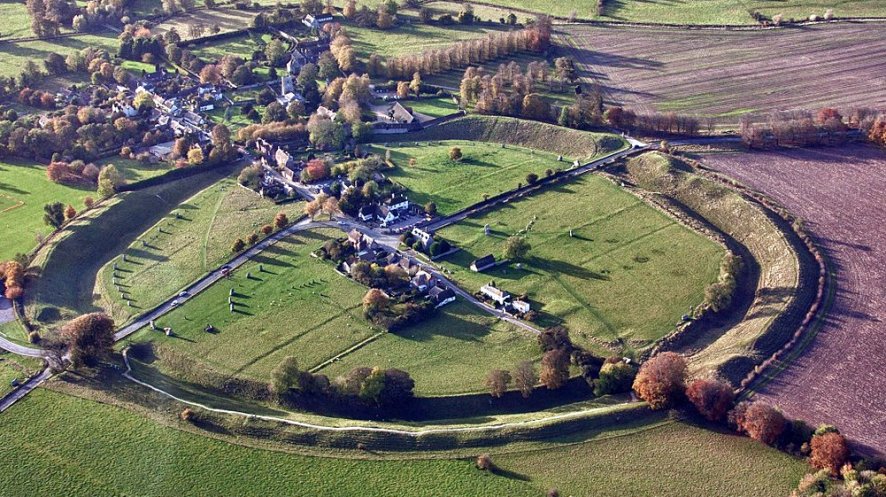
Avebury, Wiltshire
(MikPeach, CC BY-SA 4.0)
“On the banks of the Boyne is a pyramid of stones which, had it been situated on the banks of the Nile, would probably have been pronounced the oldest and most venerable of the pyramids...”

Newgrange, The Boyne Valley, Ireland
Source

The Boyne Valley, Ireland
Source
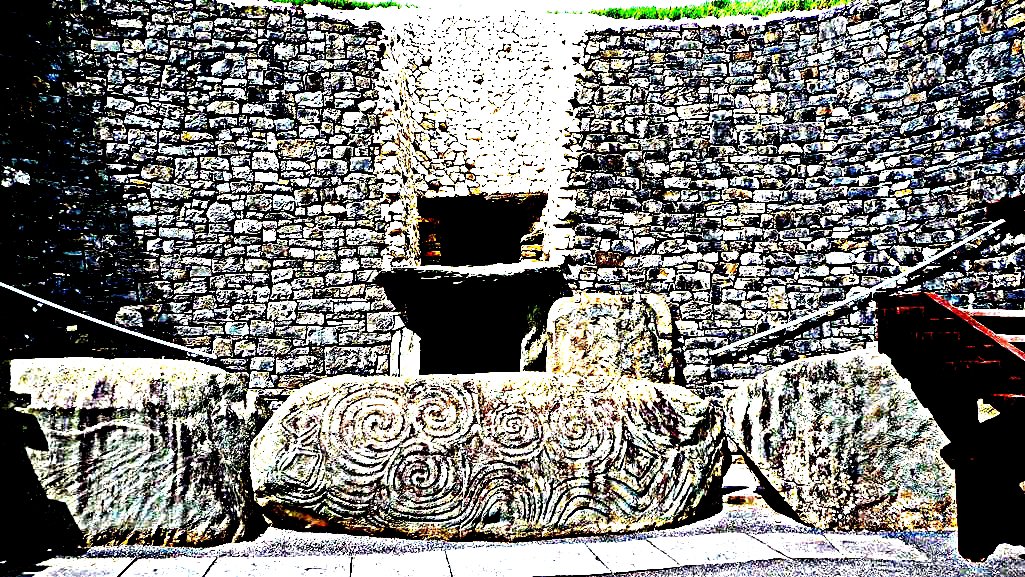
The entrance to Newgrange
(Enhanced to show the Triskele carvings)
Source
“In the Orkneys at Hoy is almost the counterpart to an Egyptian marvel which, according to Herodotus, was an edifice 21 cubits in length, 14 in breadth, and 8 in height, the whole consisting only of one single stone, brought thither by sea from a place about 20 days’ sailing from Sais. The Hoy relic is an obelisk 36 feet long by 18 feet broad, by 9 feet deep. “No other stones are near it. ’Tis all hollowed within or scooped by human art and industry, having a door at the east end 2 feet square with a stone of the same dimension lying about 2 feet from it, which was intended no doubt to close the entrance. Within, there is at the south end of it, cut out, the form of a bed and pillow capable to hold two persons.”
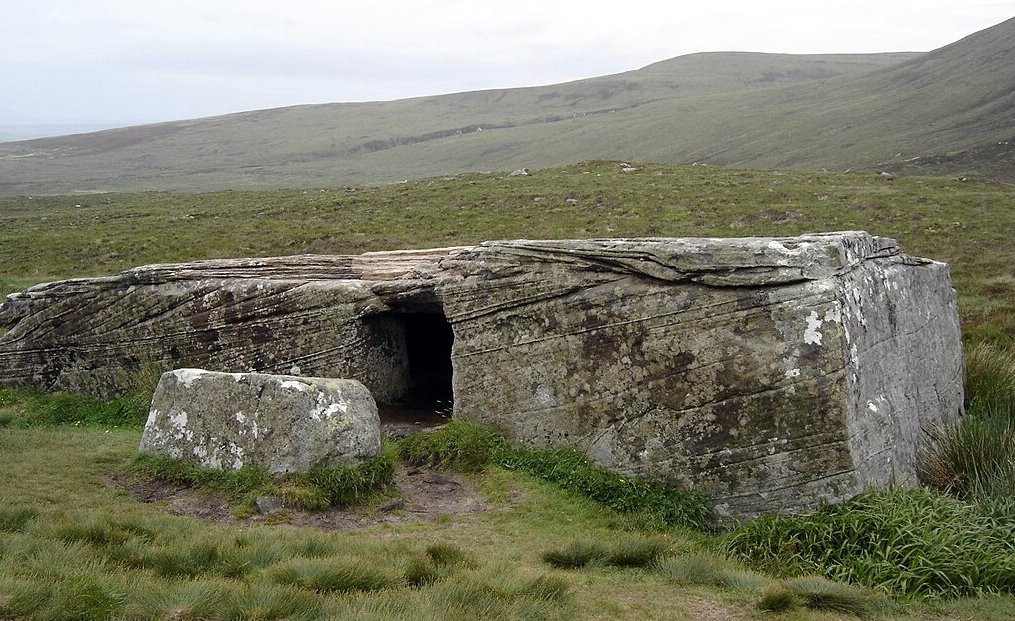
The Dwarfie Stane, Hoy, Orkney
(Grovel at English Wikipedia, CC BY 3.0)
There is a valley close by called Trowieglen, which means the home of fairy folk’. Today’s explanation of the Dwarfie Stane is that it was left there by ‘nature’ even though there are no other similar stones anywhere around. It has also shrunk… “The Dwarfie Stane is 28 feet long, 14 feet wide and 8 feet high. Part of it is sunken into the ground. Using only stone or antler tools, a passage and two cells have been hollowed out of the rock – a remarkable feat!” Source ...more like a totally unbelievable one.
“Sir John Morris-Jones has noted remarkable identities between the syntax of Welsh and that of early Egyptian: Gerald Massey, in his Book of the Beginnings, gives a list of 3000 close similarities between English and Egyptian words; and the astronomical inquiries of Sir Norman Lockyer have driven him to conclude: ‘The people who honoured us with their presence here in Britain some 4000 years ago, had evidently, some way or other, had communicated to them a very complete Egyptian culture, and they determined their time of night just in the same way that the Egyptians did’”.
So, at that time even distinguished Lords were thinking west-to-east rather than the customary east-to-west...
“It used to be customary to attribute all the mysterious edifices of these islands, including stones inscribed with lettering in an unknown script, to hypothetical wanderers from the East. Nothing could have been more peremptory than the manner in which this theory was enunciated by its supporters, among whom were included all or nearly all the great names of the period. To-day [1919] there is a complete volte face upon this subject, and the latest opinion is that ‘not a particle of evidence has been adduced in favour of any migration from the East’. When one remembers that only a year or two ago practically the whole of the academic world gave an exuberant and unqualified adherence to the theory of Asiatic immigration it is difficult to conceive a more chastening commentary upon the value of ex cathedra teaching.”
‘Ex cathedra’ “is often used to describe statements made by people in positions of authority, such as Popes or scientists, who are infallible or overbearing.” (Source) It’s difficult to know if this revolution in historical thinking took place during WWI or before, given the circumstances mentioned earlier regarding the lack of information on Harold Bayley’s life, but from the above it seems to have taken hold in just one or two years which is quite remarkable.
“By whom was the Titanic art of cromlech-building brought alike to the British Isles and to the distant islands of the Pacific? By what guidance did frail barques compass such terrifying sea space? How were these adequately victualled for such voyages, and why were the mainlands ever quitted? How and why were the colossal stones of Stonehenge brought by ship from afar, floated down the broad waters of the prehistoric Avon, and dragged laboriously over the heights of Oare Hill? Who were the engineers who constructed artificial rocking stones and skilfully poised them where they stand to-day? “To suspend a stupendous mass of abnormous shape in such an equilibrium that it shall oscillate with the most trivial force and not fall without the greatest, is a problem unsolved so far as I know by modern engineers.”
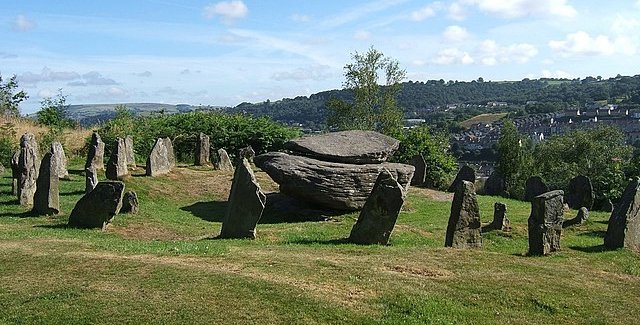
Rocking Stone, Pontypridd
(by Helen, CC BY-SA 2.0)

The 'Druidical' rocking or Logan stone at Coylton in Ayrshire, Scotland,1863.
Roger Griffith. Artwork by James Paterson, Public domain
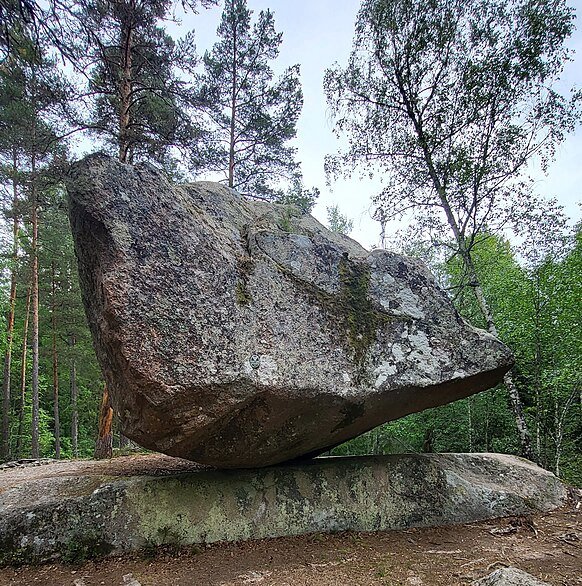
The largest moveable rocking stone in the world at Runkesten, Sweden.
(VaneTrz20, CC BY-SA 4.0)

The Sannox rocking stone on the Isle of Arran
(Charles Allen, Public domain)

The Logan or Rocking Stone on the Rhinns of Kells in Galloway, Scotland
(Roger Griffith, Public domain)
“Among the many unsolved problems of archæology are the Hebridean brochs, which are hollow towers of dry built masonry formed like truncated cones. These erections, peculiar to Scotland, are found mainly in the Hebrides, and there is a surprising uniformity in their design and construction. Among the most notable brochs are those situated at Burray, Borrowston, Burrafirth, Burraness, Birstane, Burgar, Brindister, Birsay and in Berwickshire, at Cockburnlaw, and the remarkable recurrence of Bur, or Burra, in these place-names isobviously due to something more than chance.”

Mousa Broch, Shetland, Scotland
Source
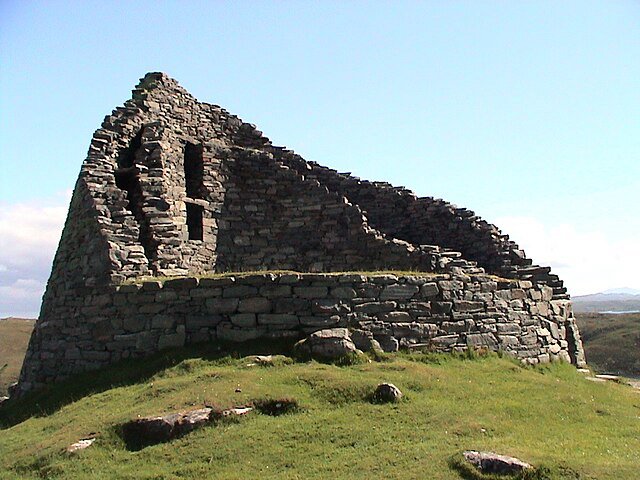
Broch Dun Carloway, Lewis, Scotland
Public domain
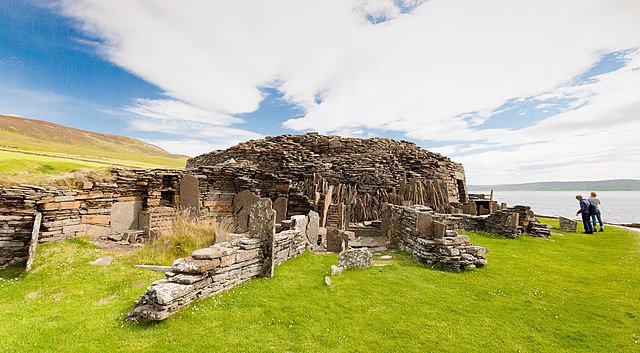
Midhowe Broch and outbuildings on Rousay, Orkney
CC BY-SA 2.0
The mystery of the Brochs is still unsolved 100 years later, despite numerous attempts to claim that they were built by ‘immigrants’ fleeing from the fantasy invasion of Romans in the south.

Broch distribution in Scotland
CC BY-SA 3.0
Prior to the 10th century cataclysm, the islands shown on the map were probably all connected to the mainland(s.)
“Who were the philosophers who spun a delicate gossamer of fairy-tales over the world, and formulated the cosmic ideas which are in many extraordinary respects common alike to primitive and more advanced peoples? And why is the symbol generally entitled the Swastika cross found not only under the ruins of the most ancient Troy but also in the Thames at Battersea, and elsewhere from China to Zimbabwe? How is it that Ireland, that remote little outpost of Europe, possesses more Celtic MSS. than all the rest of Celtic Europe put together?”
Maybe, all of a sudden around 1918, people just started asking the right questions?
“Our churches stand to-day not only on the primeval inconvenient hill-sites, but frequently within the time-honoured earthwork, or beside the fairy-well. On Palm Sunday the villagers of Avebury still toil to the summit of Silbury Hill, there to consume fig cakes and drink sugared water; and on the same festival the people even to-day march in procession to the prehistoric earthwork on the top of Martinshell Hill. Our country fairs are generally held near or within a pagan earthwork, and instance after instance might be adduced all pointing to the immortality of custom and the persistent sanctity of pagan sites...
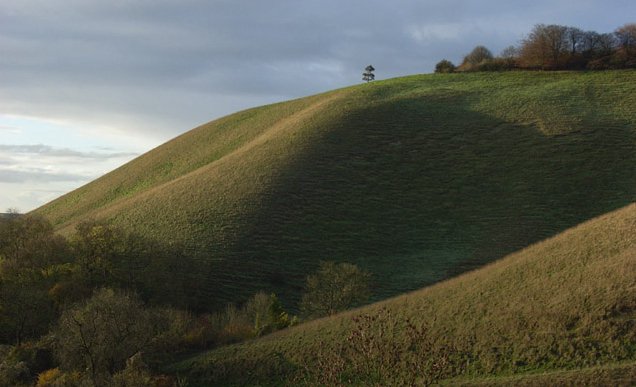
Martinsell Hill
(Andrew Smith / Martinsell Hill)
“The Augustine of Canterbury, who is recorded to have baptised on one day 10,000 persons in the river Swale, recommended with pious ingenuity that the heathen temples should not be destroyed, but converted to the honour of Christ by washing their walls with holy water and substituting holy relics and symbols for the images of the heathen gods. This is an illuminating sidelight on the methods by which the images of the heathen idols were gradually transformed into the images of Christian saints, and there is little doubt that as the immemorial shrines fell into ruin and were rebuilt and again rebuilt, the sacred images were scrupulously relimned (to limn or adorn anew...)
“The earliest British shrines were merely stones, or caves, or holy wells, or sacred trees, or tumuli, preferably on a hill-top or in a wood. The next type is found in the monastery of St. Bride, which was simply a circular palisade encircling a sacred fire.”

St Brigid's Fire Temple, Kildare, Ireland
Source
What we see today in the image above are the foundations of a possible temple on the site of St. Bride’s monastery...
“The sacred fire of St. Bridget was kept going at Kildare until the thirteenth century when it was suppressed by the Archbishop of Dublin. It was, however, relighted and maintained by the nineteen nuns of St. Bridget —the direct descendants of nineteen prehistoric nuns or Druidesses— until the time of the Reformation, when it was finally extinguished.” (Archaic England, Harold Bayley.)
In 1993 the flame was relit by the Brigidine sisters of Kildare . Since then, they have tended the flame in their Centre at Solas Bhride. Source
As Harold Bayley was writing around 1919, the “monastery of St. Bride” he was referring to must be the one in Kildare, Ireland and not the one that has recently been ‘discovered’ in Glastonbury, Somerset and claims to be the oldest monastic ruins in England. By some revised, obviously Bayesian carbon-dating, the Glastonbury site has now been dated to coincide exactly with the St. Bride tradition of Kildare. “Fascinatingly, the woman who was anointed St. Brigid after her death began her religious life as a high priest in a Druidic temple dedicated to the Celtic triple goddess Bride, Brigit and Brighde. In fact [WS: in fact?!] the woman adopted the name of Brigid in honor of this revered goddess (she was Celtic by birth and heritage), and kept the name after she converted to Christianity sometime in the mid-to-late fifth century.” Source
I think it would be more “factually” accurate to say that she was converted by Christianity, in the sense of being redefined as a Christian Saint rather than claiming that she converted at some unknown point in time.
Saint Bride or Brigit, Bryth even Brigid was a well-travelled girl. Kildare in Ireland is considered to be her base of operations, but she appears in many other places. ‘The Dictionary of Celtic Mythology’ tells us that at least 19 churches dedicated to St. Brigid of Kildare were found across Scotland, Wales, England and the Isle of Man before the Reformation. Argyll and the Outer Hebrides of Scotland were particular strongholds of devotion to St Brìde during the Middle Ages, where we find St. Brigid’s cross and the Brideog, a doll or effigy of St Brigid that was taken from house to house in a locality on the eve of her feast day. Source
Harold claims that it was originally a sheaf of grain that was carried from door to door and that “the word Hebrides may perhaps be rendered ‘eu Bride’” and that Bride, Brid or Bryth gave her name to the Brythons and subsequently Britannia… then logically ‘Britain’.
Perhaps St. Bride’s Field and Mound in Glastonbury is where she used to land her helicopter. In the British Isles we have place names such as Bride in the Isle of Man, Bridekirk in Cumbria, Bridestow and Bridford in Devon, Brideswell in Aberdeenshire, Bridport in Dorset and Bridstowe in Herefordshire, St. Bride’s Bay in Wales not to mention a great many places beginning with ‘Bridg-’ not all of which refer to bridges.
There’s something staring us right in the face here. When people get married in the United Kingdom in an English ceremony, the ritual involves the exchanging of vows between a Bride and a Bridegroom. Often there are also Bridesmaids present. If you look up the modern ‘official‘ etymology of the words Bride, Bridegroom and Bridesmaid they will give you what can best be described as a load of old twaddle.
What’s going on here is a microcosm of the Sacred Marriage, or Hieros Gamos, whereby the Bride represents the Mother or Earth Goddess and the Bridegroom her consort. The Bridesmaids are the attendants of the goddess. Bride, or Brigid etc., is one name of the goddess, probably a later one, but there have been others. A Groom is traditionally a male who looks after a horse or horses, who would lead or guide a horse using a Bridle (anciently Bridel) that fits over the horse’s head. This could have easily referred originally to some form of decorative garland or headdress. The concept of a Bridegroom and a Bridle points towards Epona / Rhiannon / Macha, the goddess who, from the earliest of times, took the form of a horse. This is discussed in the article The Horse, Silent Witness to the Past.
This ancient ceremony has obviously been heavily ‘Christianised’ over the centuries and now symbolises “the union between Christ and his Church,” but its true roots are still there to be seen for those willing to take a proper look. What’s truly fascinating is that the Sacred Marriage of the King to the Goddess (representing the land or the earth,) which we now know as a ‘coronation’, also had its equivalent in the marriage of the ordinary folk who underwent their own version of the Sacred Marriage and thereby shared in the Sovereignty of the land. The importance of this cannot be emphasised enough as we move on to sift more of the 'detritus' in the next forthcoming article.
The hiatus in the official narrative described above, obviously didn’t last. It’s interesting to note that it took place at around the same time as the establishment of Hollywood as the centre for the motion picture industry and the introduction of radio communication, both major instruments of mass thought control by which the fear-distraction could be maintained and extended.
The vast majority of world religions recognise the cyclic procession of the seasons and celebrate the ‘rebirth’ event of the sun – in some disguise or other. The older Pagan traditions are totally connected to the changing seasons throughout the year and they have always held the winter solstice to be a time of positive change. Perhaps we have lost sight of the greater cycles of decades, centuries and millenniums and such knowledge is now used against us by those who wish us to live in a state of permanent fear and suffering.
In 1688, just before the beginning of the 18th century, there was the ‘Glorious Revolution’ in England when James II was overthrown by William of Orange, the Dutch puppet, and the Bank of England was established along with the National Debt and the introduction of paper money soon followed. This was the beginning of great and devastating social changes that took place in England throughout the 1800s which included the Industrial Revolution.
At the end of the 18th century there was a widespread shift from agrarian to industrial based economies along with the French Revolution. At the beginning of the 19th century the Napoleonic Wars caused havoc across Europe and who knows what that was all really about? Also, let’s not forget that in the early 20th century there was a socialist/communist revolution in Russia as well as a World War.
100 years later we have the same phenomena in terms of the official narrative being questioned, except this time it has risen from within the ranks of ordinary unofficial people who, quite shamefully, began thinking for themselves. The internet evolved just before the last millennium and has now placed itself at the forefront of thought control and fear-distraction. The big difference this time is that it’s a new millennium, therefore, maybe the energy assisting social change is much stronger.
In the early 21st century – the New Millennium – we have had a worldwide pandemic enforced by extreme socialist/communist tyranny. If the energy now available for social change has been amplified by the millennium chronology, this goes some way to explaining the massive ongoing fear-distraction. That energy is neither good nor bad, it’s neutral. The use to which it’s put decides if it’s good or bad. We can use it to make the changes we need!
The Dark Earth Chronicles Part One
The Dark Earth Chronicles Part Two
The Dark Earth Chronicles Part 2.5
Editorial Update March 2024
The ‘History Revolution’ of the early 20th century
The Grail, The Cataclysm, The Wasteland and Our Lost Ancient Sovereignty
Updates and Re-Evaluation
Taliesin, The Divine Poisoner
Will Scarlet
.
IF YOU ARE SEEING A LINK TO MOBIRISE, OR SOME NONSENSE ABOUT A FREE AI WEBSITE BUILDER, THEN IT IS A FRAUDULENT INSERTION BY THE PROVIDERS OF THE SUPPOSEDLY 'FREE' WEBSITE SOFTWARE USED TO CREATE THIS SITE. THEY ARE USING MY WEBHOSTING PLATFORM FOR THEIR OWN ADVERTISING PURPOSES WITHOUT MY CONSENT. TO REMOVE THESE LINKS I WOULD HAVE TO PAY A YEARLY FEE TO MOBIRISE ON TOP OF MY NORMAL WEBHOSTING EXPENSES - WHICH IS TANTAMOUNT TO BLACKMAIL. I CALCULATE THAT THEY CURRENTLY OWE ME THREE MILLION DOLLARS IN ADVERTISING REVENUE AND WEBSITE RENTAL.